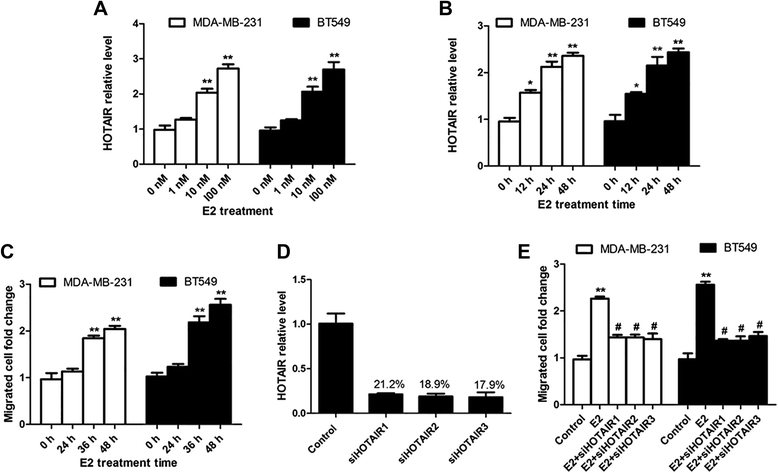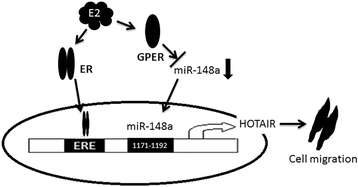Estradiol induces HOTAIR levels via GPER-mediated miR-148a inhibition in breast cancer
- PMID: 25928008
- PMCID: PMC4421993
- DOI: 10.1186/s12967-015-0489-x
Estradiol induces HOTAIR levels via GPER-mediated miR-148a inhibition in breast cancer
Abstract
HOTAIR plays an important role in the regulation of cancer cell proliferation and cancer invasion in breast cancer. The up-regulation of HOTAIR has been reported in both estrogen receptor (ER) positive and triple-negative (TN) breast cancer. It has been reported that HOTAIR is regulated by estrogen (E2) via ERs in ER-positive breast cancer. However, it is unknown how HOTAIR is regulated in TN breast cancer. In this study, we found that HOTAIR was increased in the peripheral blood mononuclear cells and cancer tissues from breast cancer patients, and was especially higher in patients with metastatic breast cancer. In addition, we found that estrogen promoted HOTAIR through its receptor GPER and estrogen-induced breast cancer cell migration was reversed by deleting HOTAIR in TN breast cancer cells MDA-MB-231and BT549. Furthermore, we identified that E2-GPER induces the level of HOTAIR through the suppression of miR-148a. miR-148a level was negatively correlated with HOTAIR level in breast cancer patients. After the mutation of the predicted miR-148a binding sites in HOTAIR, miR-148a had no effect on HOTAIR. In conclusion, our findings offer important new insights into the ability of estrogenic GPER signaling to increase the HOTAIR level by inhibiting miR-148a in breast cancer.
Figures





Similar articles
-
GPER mediated estradiol reduces miR-148a to promote HLA-G expression in breast cancer.Biochem Biophys Res Commun. 2014 Aug 15;451(1):74-8. doi: 10.1016/j.bbrc.2014.07.073. Epub 2014 Jul 22. Biochem Biophys Res Commun. 2014. PMID: 25063027
-
Long noncoding RNA HOTAIR mediates the estrogen-induced metastasis of endometrial cancer cells via the miR-646/NPM1 axis.Am J Physiol Cell Physiol. 2018 Jun 1;314(6):C690-C701. doi: 10.1152/ajpcell.00222.2017. Epub 2018 Feb 21. Am J Physiol Cell Physiol. 2018. PMID: 29466670
-
GPER mediates enhanced cell viability and motility via non-genomic signaling induced by 17β-estradiol in triple-negative breast cancer cells.J Steroid Biochem Mol Biol. 2014 Sep;143:392-403. doi: 10.1016/j.jsbmb.2014.05.003. Epub 2014 May 27. J Steroid Biochem Mol Biol. 2014. PMID: 24874276
-
The Long Noncoding RNA HOTAIR in Breast Cancer: Does Autophagy Play a Role?Int J Mol Sci. 2017 Nov 3;18(11):2317. doi: 10.3390/ijms18112317. Int J Mol Sci. 2017. PMID: 29469819 Free PMC article. Review.
-
Comprehensive understanding of the role of GPER in estrogen receptor-alpha negative breast cancer.J Steroid Biochem Mol Biol. 2024 Jul;241:106523. doi: 10.1016/j.jsbmb.2024.106523. Epub 2024 Apr 16. J Steroid Biochem Mol Biol. 2024. PMID: 38636681 Review.
Cited by
-
An emerging link between lncRNAs and cancer sex dimorphism.Hum Genet. 2024 Jul;143(7):831-842. doi: 10.1007/s00439-023-02620-7. Epub 2023 Dec 14. Hum Genet. 2024. PMID: 38095719 Free PMC article. Review.
-
The Role of Mir-148a in Cancer.J Cancer. 2016 Jun 21;7(10):1233-41. doi: 10.7150/jca.14616. eCollection 2016. J Cancer. 2016. PMID: 27390598 Free PMC article. Review.
-
Long Non-Coding RNA in the Pathogenesis of Cancers.Cells. 2019 Sep 1;8(9):1015. doi: 10.3390/cells8091015. Cells. 2019. PMID: 31480503 Free PMC article. Review.
-
Expression Profiles of Estrogen-Regulated MicroRNAs in Cancer Cells.Methods Mol Biol. 2022;2418:313-343. doi: 10.1007/978-1-0716-1920-9_18. Methods Mol Biol. 2022. PMID: 35119673
-
Characterizing the tumor RBP-ncRNA circuits by integrating transcriptomics, interactomics and clinical data.Comput Struct Biotechnol J. 2021 Sep 17;19:5235-5245. doi: 10.1016/j.csbj.2021.09.019. eCollection 2021. Comput Struct Biotechnol J. 2021. PMID: 34630941 Free PMC article.
References
MeSH terms
Substances
LinkOut - more resources
Full Text Sources
Other Literature Sources
Medical
Miscellaneous

